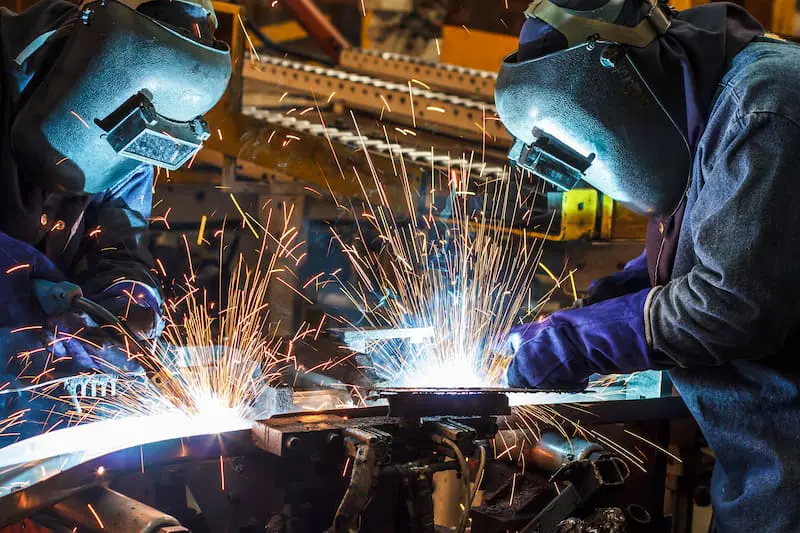TIG and MIG welding processes are usually the first choice for metal parts assembly. They are easy to carry out and give you precise control over the operation. When choosing the best welding technique, speed and efficiency come into play. Welding speed is critical as it determines the quality and overall productivity of the process.
As a welding professional or DIY enthusiast, it is common to wonder about the welding technique that supersedes in terms of speed and turnaround. While TIG welding may be the gold standard for many, MIG welding is faster which makes it a good choice for high-volume applications. This article will explain the factors that affect welding efficiency and determine the faster process between TIG and MIG welding.
What is TIG (Tungsten Inert Gas) Welding?
TIG welding also known as GTAW (gas tungsten arc welding) is a process that uses a non-consumable tungsten electrode to join two or more metal pieces. The result of this welding technique is a strong and clean joint that may not need further finishing. To carry out TIG welding, you set up the machine and clean your workpiece. You then hold the torch close to the workpiece at a suitable distance and angle.
Thereafter, touch the metal piece with the tungsten electrode and withdraw it to create an arc. The electric arc heats the electrode and the workpiece to create a weld pool. You can add filler material if needed when the gap is significantly larger. On completion, gradually reduce the arc current and allow the pool to cool. You then inspect the final weld for abnormalities. TIG welding is relatively fast and does not affect the structural integrity of the base metals. You can use it for initial fabrication or repair in many manufacturing industries including automotive and aerospace.
What is MIG (Metal Inert Gas) Welding?
You can also refer to MIG welding as gas metal arc welding (GMAW). This arc welding process uses a continuous wire electrode to join two or more metal pieces. The electrode in MIG welding is consumable and needs frequent replacement as it becomes part of the weldment. The process of MIG welding is similar to that of TIG welding. MIG welding also forms an arc that melts the wire electrode and base metal to create a joint.
When carrying out the MIG welding process, it is important to use a shielding gas including argon, helium, and oxygen. These shielding gasses protect the weld pool from contamination and ensure that the joint is of a high quality. MIG welding is compatible with many engineering metals such as aluminum, steel, and copper. This welding technique has applications in the assembly of heavy industrial equipment. You can also use it to weld pipes or repair automotive components.
Which is Faster: TIG or MIG Welding
When comparing TIG and MIG welding techniques in terms of speed, the latter is better. MIG welding is fast and offers productivity benefits. The reasons for this are not far-fetched. In MIG welding, you continuously feed in the wire electrode. This feature allows for faster welding speed even for thick workpieces.
Furthermore, the travel speed of this technique is fast and reduces welding time. Another reason behind the speed of MIG welding is the stable arc it produces. The electric arc is consistent and controlled. Hence, the base metal and electrode heat up faster to produce high-quality and visually appealing welds.
Key Factors that Affect Welding Efficiency
Some factors affect welding efficiency and serve as ways of differentiating between MIG and TIG welding. Some of these factors include
- Material Thickness
The thickness of the metal pieces you are working with determines how the process will go. Thinner materials are easier to weld because they need minimal heat input for a successful action. Furthermore, they are less prone to warping and distortion. When comparing MIG to TIG welding in terms of material thickness, MIG welding has an edge. This technique provides good penetration for metals thicker than ⅛ inch.
- Post-Weld Cleanup
The level of cleaning and processing you need to carry out after welding is another factor that affects welding efficiency. This is because the as welded finish may not be sufficient for aesthetics and performance. The post-weld cleanup for MIG welding is more time-consuming and labor-intensive. The reason behind this is the rougher surface finish as a result of the spatter produced. Conversely, TIG welds are cleaner and may not need post-processing.
- Positioning
The way you position the torch will determine the result of the welding process. You hold the torch around 10 to 15 degrees from the direction of the weld to get the best results. MIG welding tools are flexible and little deviation from the standard torch angle is permissible. This allows you to make adjustments as needed. On the other hand, proper welding positioning is crucial with TIG welding. You must maintain the right angle and distance for an efficient welding process.
- Welder Skill Level
Your skill level will inevitably affect the result of the welding operation. Your experience and expertise will determine how well you can create clean and durable joints. If you are carrying out MIG welding, you will find it more straightforward. The learning curve is shorter for those just starting. However, TIG welding operations are more rigorous. There is a need for precision and control for demanding applications.
- Heat Input
The amount of heat you introduce to join the base metals is another factor. The heat input must be optimal to ensure deep penetration and prevent inadequate fusion. This heat input differs and depends on the workpiece’s properties and thickness. Generally, MIG welding comes with higher heat requirements. The heat input must be optimal for you to maintain a stable arc.
- Type of Joint
The type of joint also affects welding efficiency. There are different joint types which can be butt, edge, or lap. The time you will take to prepare the workpiece and produce the different joints differs. For instance, edge joints are more time-consuming if you place them side by side with butt joints. Note that MIG welding is more versatile than TIG welding when it comes to joint compatibility. MIG welding requires less rigorous preparation and you can use it for many joint types.
Conclusion
MIG and TIG welding techniques are fast and get your products to market on time. However, MIG welding has a higher speed because you continuously feed in the wire electrodes to produce precise and clean welds. However, some factors determine the speed and efficiency of the welding operation. Some of these include the thickness of the workpiece, the amount of heat input, and how you position the workpiece. The type of joint you want to make and your skill level are also important factors. Are you looking for professional MIG or TIG welding services? Reach out to a MIG-TIG welder for a mind-blowing experience.










